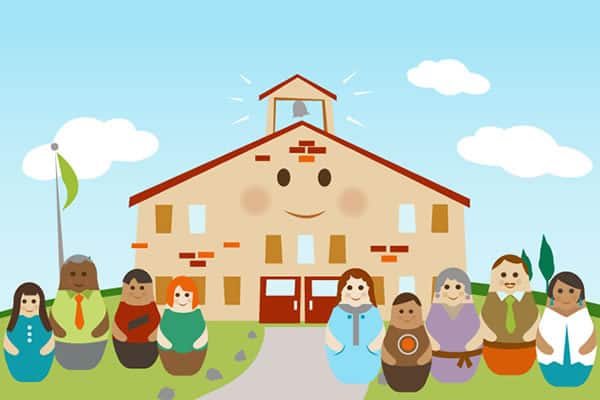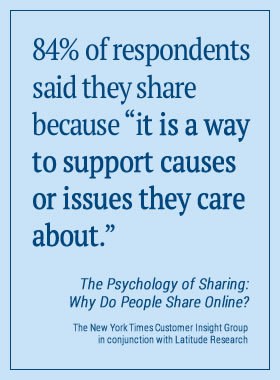
This post is part of our #Share4Schools social sweepstakes series, designed to help schools engage supporters in social circles to promote fundraising—and possibly win cash prizes. While some of these articles reference #Share4Schools, the concepts are universal.
Sharing Your Fundraising “Asks” on Social Media
Social media is often a polarizing subject that can be largely misunderstood as a results driven marketing tool. To better measure your social media success, it’s good to know what social networks are best at and what to expect from your efforts.
Tell Us About Yourself
Why People Share
In the study “The Psychology of Sharing: Why Do People Share Online?” conducted by The New York Times Customer Insight Group in conjunction with Latitude Research showed 84% of respondents said they share because “it is a way to support causes or issues they care about.” Read more about why people share
Social media has proven to be a valuable supporter in driving online fundraising, but not necessarily the direct path to donations.
An American Red Cross survey shows “While social engagement plays a role in many decisions, it is not the key driver”. Social media does play a significant role in a nonprofit’s communication strategy even though it might not be a strong closer.
How to Approach Social Sharing
Social Media is a conversational 2-way street where individuals connect with each other, and to a lesser extent, connect with brands. There are a number of great Social Media resources to get started including Facebook’s Tips For Causes and Nonprofits and this detailed guide.

Currently, data shows that social plays a supporting role in online fundraising and that’s exactly what Peace and Paws and their half a million likes on Facebook did to raise $70,000 for construction of the Ruff House Retreat.
Include your donate button and any other call-to-action you have on those social profiles, but focus your efforts on connecting with your following first. Think about social networks in an office watercooler scenario—post your “asks” close to the watercooler, but focus on the conversations.
Mobilizing Your Social Networks
If you have an engaged following on social media, chances are you have been through this exercise before. I’d love to hear your own tips and tricks.
Here are a few things that may help produce results:
- Craft your message in different ways to reach different profiles—There are usually several narratives that will reach different segments of your audience. Use those narratives to create multiple social messages for the same “ask”.
- Figure out your timing—Monitor your social analytics to see when your audience is online and use that information to time ypur posting activities. Use your variable messaging to schedule multiple posts around the same topic and get a sense for frequency and timing of multiple posts to maximize engagement.
- Incentivize your plea—Schools may set a goal and offer an ice cream party if the goal is reached.
Rejuvenating Your Social Networks
If it’s been a while since you posted or even accessed your social media accounts, now would be a great time to do a quick review. Many of the networks have updated their privacy (Facebook & Twitter) photo sizes—and a fresh look is usually not a bad thing. Plus your followers may get notified that you have uploaded a photo or changed your profile.
Research what images, videos, graphics and stories you have received recently. Use these items to re-engage your audience and focus on maintaining a consistent posting schedule.
Resuscitating Your Social Networks
If you created a social account or two, but quickly got pulled back into everyday business, you aren’t alone! Keep in mind that social networks are a very real way for potential supporters to find and connect with you. One of the primary activities for all users online revolves around one or more of the social networks. 79% of internet users use Facebook and the fastest growing segment is adults over the age of 65.
Start with a basic overhaul of your profiles—here is a reference page for photo sizes. Gather any images, stories, videos or other interesting information that has to do with your organization and start sharing it. It’s O.K. if you don’t have a big following before you start sharing. People want to see what your about before they follow you and you’ll need some content for them.
If you haven’t reached out to your supporter base, asking them to connect with you socially, send a communication asking them to connect and share with them some of the benefits they’ll receive for following you:
- Here it on social first—you make announcements through Social Media first.
- Don’t miss any events—You’ll post all daily event information to Social Media.
- Special notices and contests—If an author is making a surprise visit or you hold ongoing hashtag contests.
Make sure you are adding your social channels to all of your current communications to provide a consistent reminder and be available when your recipients are new or unfamiliar with you. Also, look at other organizations that are similar to you and see what they are doing in Social Media. You may find some interesting ideas to share.
Wrapping It All Up
Social might not be the direct path—although it might be for some—but it can have a significant influence on those that eventually get to the path. Remember, Social Media is a place where content connects on a more personal level and consistently flows. Get your best content together, weave new stories and connect with your supporters where they are.
